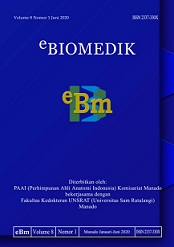Uji Efek Anti Bakteri Madu Hutan dan Madu Hitam Terhadap Bakteri Staphylococcus aureus, Escherichia coli, dan Pseudomonas aeruginosa
DOI:
https://doi.org/10.35790/ebm.v8i1.28704Abstract
Abstract: Honey contains plenty of antibacterial components, among them are high osmolarity, acidic pH, hydrogen peroxide, and antimicrobial proteins. The aim of this study is to determine in vitro antibacterial activity of forest honey and black honey against Staphylococcus aureus, Escherichia coli, and Pseudomonas aeruginosa. The method used is experimental laboratory with dilution method at University of Sam Ratulangi Faculty of Mathematics and Natural Sciences Microbiology Laboratory. Concentrations of honey used are 100%, 50%, 25%, 12,5%, 6,25%, 3,125%, 1,56% dan 0,78% (v/v) respectively. Ciprofloxacin as positive control and aquadest as negative control. The results obtained in this study is that both forest honey and black honey exhibited antibacterial activity. The Minimum Inhibitory Concentration (MIC) of forest honey towards S. aureus, E. coli, and P. aeruginosa is 12,5%, 12,5%, and 25%. The MIC of black honey towards S. aureus, E. coli, and P. aeruginosa is 25%, 12,5%, and 25%. No Minimum Bactericidal Concentration (MBC) is found on both forest honey and black honey. In conclusion, forest honey and black honey exhibited antibacterial activity against Staphylococcus aureus, Escherichia coli, and Pseudomonas aeruginosa bacteria. The antibacterial effect of forest honey superior to black honey by a small margin.                                                                                                      Keywords: antibacterial, forest honey, black honey, Staphylococcus aureus, Escherichia coli, Pseudomonas aeruginosa
Â
Â
Abstrak: Madu memiliki banyak komponen antibakteri, diantaranya osmolaritas yang tinggi, pH asam, hidrogen peroksida, dan protein antimikroba. Penelitian ini bertujuan untuk menentukan aktivitas antibakteri in vitro madu hutan dan madu hitam terhadap Staphylococcus aureus, Escherichia coli, dan Pseudomonas aeruginosa. Metode yang digunakan yaitu eksperimental laboratorium dengan metode dilusi di Laboratorium Mikrobiologi Fakultas MIPA Universitas Sam Ratulangi. Konsentrasi madu yang digunakan ialah 100%, 50%, 25%, 12,5%, 6,25%, 3,125%, 1,56% dan 0,78% (v/v) secara berurutan. Ciprofloxacin sebagai kontrol positif dan akuades sebagai kontrol negatif. Hasil yang didapatkan pada penelitian ini yaitu kedua madu hutan dan madu hitam menunjukkan sifat antibakteri. Minimum Inhibitory Concentration (MIC) pada madu hutan terhadap S. aureus, E. coli, dan P. aeruginosa adalah 12,5%, 12,5%, dan 25% (v/v). MIC pada madu hitam terhadap S. aureus, E. coli, dan P. aeruginosa adalah 25%, 12,5%, dan 25% (v/v). Tidak ditemukan Minimum Bactericidal Concentration (MBC) pada kedua madu hutan dan madu hitam. Efek antibakteri madu hutan lebih kuat daripada madu hitam. Simpulan penelitian ini ialah madu hutan dan madu hitam memiliki efek antibakteri terhadap bakteri Staphylococcus aureus, Escherichia coli, dan Pseudomonas aeruginosa. Efek antibakteri madu hutan sedikit lebih besar daripada madu hitam.           Â
Kata Kunci: antibakteri, madu hutan, madu hitam, Staphylococcus aureus, Escherichia coli, Pseudomonas aeruginosa




